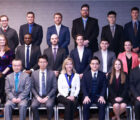Having a diverse work force enables business leaders to understand the many facets of a competitive corporate world, and it can be financially beneficial as well.
Four members of the CAS shared ideas on how to increase diversity within the profession at the Society’s 2015 Annual Meeting in Philadelphia.
In March 2015, the CAS adopted a formal Diversity Strategy that encourages an inclusive community where differences are celebrated and lists several specific strategies to accomplish that goal. The CAS Annual Meeting session was a chance for open discussion on how to continue furthering this strategy.
David Terné, a Fellow of the CAS and an assistant vice president at the Hartford, showed the CAS statistics indicating that in recent years newly credentialed actuaries have come from a variety of backgrounds. The number of Asian actuaries, for example, is growing rapidly. In the past five years more than one-fourth of new actuaries self-report Asian descent, about 10 times the share in 1989. The share of other U.S. minorities is growing slowly, but remains tiny, each under 2 percent of the newly credentialed.
“There is a mixed picture,” Terné said. “For Asians the percentage has gone up, which is great, but we still struggle with other demographic classes.”
And the growth in diversity comes in part from the CAS’s increasingly international reach. Many of the new Asian actuaries are based in Asia.
Most of the growth in actuaries of African descent comes from persons born in Africa or the Caribbean, noted CAS Fellow Arthur Randolph, a senior consulting actuary at Pinnacle Actuarial Resources.
“It makes us ask what we are not doing here in the United States that other countries have already figured out,” he said.
Incoming CAS President-Elect Nancy Braithwaite, FCAS, noted that there are many measures of diversity that are not as easy to quantity, such as sexual orientation, religion, disability or military service. “We look at the numbers we have in front of us, but they can’t always give us the whole picture,” she said.
The CAS already does some outreach with diversity initiatives, including work from the Joint CAS/SOA Committee on Career Encouragement and Actuarial Diversity (JCCEAD) and the CAS Diversity Committee, chaired by Terné. The CAS Diversity Committee has representation from the International Association of Black Actuaries (IABA), with whom it coordinates events.

Among the efforts that the CAS currently participates in (often in conjunction with the JCCEAD):
- Reimbursing exam fees for diverse candidates.
- Partially funding universities with summer programs for diverse students.
- Building stronger relationships with professional STEM (science, technology, engineering and math) organizations that focus on diverse groups.
- Fostering communication across the society regarding diversity issues.
Today scholarships also remain an important incentive in diversity work. Both panel moderator Roosevelt Mosley, FCAS, and fellow panelist Randolph were recipients of diversity scholarships from the Joint CAS/SOA Committee on Career Encouragement and Actuarial Diversity.
The aid helped, Mosley said, but “Just giving scholarships is not enough to encourage diversity.” The IABA, for example, was finding that there weren’t a lot of persons of African descent in high school STEM programs, meaning the pool of potential candidates had shrunk before college.
In addition, the actuarial profession, despite repeated No.1 rankings as the best job in America, remains one of the more obscure math-centric professions. “We’re competing with the accountants, the engineers, the scientists,” Mosley said, whose reputations are well-known at the middle-school level and even earlier grades.

The CAS is doing its part to actively engage student audiences through its CAS Student Central program, which provides free membership and resources to students looking to pursuing a career as an actuary. However, more can always be done to continue championing these efforts.
Braithwaite mentioned that it is important to increase the visibility of diverse groups by, for example, recruiting diverse speakers at actuarial meetings — more Asians, African-Americans, women and persons from India presenting.
Randolph recommended that actuaries themselves become educated on why diversity is important in the workplace. Organizations thrive when many points of view are represented, he said, and a healthy CAS — and a healthy profession overall — will continue to depend on diversity.
“This is a critical next step for us as an organization,” Randolph said.











